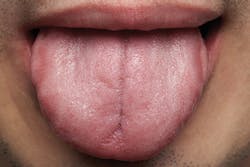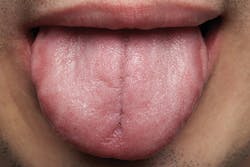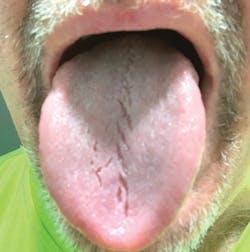The neglected duty
Kristin Goodfellow, RDH
I recently conducted an unscientific “study”—and by study, I mean I asked 20 healthy people the following questions: “During your last dental visit did anyone mention to you how to clean their tongue? Did anyone talk about the bacteria that lives on your tongue? Did they talk about your tongue at all?” Not one of them could recall a time that their hygienist or doctor talked to them about any type of regular care for their tongue. They were all in fairly good dental health.
This raises the question: If the patient is healthy, there is no coating on the tongue, and the mouth has no foul odor, do we even talk about the tongue during the appointment? I do not recall being taught in dental hygiene school to clean the tongue. I even remember being graded on my evaluation of the tongue, but never on my skill at caring for the tongue. We all know that this particular area of the mouth is a cesspool for pathogens that can lead to additional issues. So shouldn’t we be having more conversations about caring for the tongue? Just as we care for teeth and the surrounding tissues, we should not neglect this duty that falls into our laps as registered dental hygienists. Even if my unscientific study is only half right, that is still a lot of patients not caring for this rather large portion of the mouth. That’s why I refer to this as the “neglected duty.”
© Dimarik16 - Dreamstime.com
Why it needs to be addressed
I know neglect is a strong word, and that we don’t intentionally ignore the tongue. But the tongue can provide important clues about a patient’s overall health. Additionally, without a healthy tongue, we could struggle to eat, breathe, speak, and swallow. It is simply time to develop some new skills around our approach to caring for this incredibly important organ. We need be sure to pay attention to healthy everyday tongues, and not just those with obvious issues. Because just like teeth and gums, the tongue can easily become unhealthy. Over half the bacteria in the mouth is present on the tongue.1 This can also contribute to other issues. Currently, if we talk about the tongue, it is usually a conversation about bad breath. Many of us know the connection between the tongue and odor, but the causes of malodor create issues that extend beyond bad breath. The volatile sulfur compounds (VSCs), which are released from the bacteria, are what you smell, but they are also linked to the progression of gum disease, and delayed wound healing.2 Since the tongue is the largest accumulator of plaque in the mouth, it is also the ideal environment for pathogens to thrive.3
Figure 1 is an example of a “healthy” tongue (left). But look at the amount of debris this patient was able to scrape off (right)!
Figure 1: Debris (right) a patient was able to scrape from a “healthy” tongue
Starting the conversation
There are two schools of thought on cleaning the tongue. One is to do it for patients during the appointment, or have patients do it for themselves during the appointment. Whichever way you choose is fine, but to make tongue cleaning important, we must start the conversation in the office, just like we do with brushing and flossing.
The goal is for patients to care for their tongue every day at home. Look—the past is the past, but we now know that cleaning the tongue is important, so we must educate our patients. We should all have a tongue scraper on our tray, just like we have a strand of floss. Be sure to tell patients that even though their tongues may appear clean now, that bacteria will repopulate, and so this step must be repeated daily. This actually goes for the whole mouth. Patients should consider their cleanings as a fresh start down a healthier path.
The right tools
Some patients attempt to care for their tongue by brushing it with their toothbrush. This mostly moves the bacteria and other pathogens on the tongue around and does little as far as removal.4 If they are using the same toothbrush to brush their teeth, they could also be spreading bacteria that causes additional issues. This is why a tongue scraper should be used both in the office and at home. Specialized areas require specialized tools, just like floss is used to clean interproximal surfaces of the teeth, a tongue scraper should be used to clean the tongue. Thirty percent more bacteria can be removed by scraping the tongue than just by brushing.5 Furthermore, for patients with a bad gag reflex, a tongue scraper does not aggravate this response as much as a toothbrush.
Patients can have an extremely difficult time reaching many areas of the tongue, including the dorsal and lateral portions. So just using a tongue scraper will not be enough to care for these vulnerable areas. This is where choosing a rinse comes in. Rinses not only help with untouched areas of the tongue, but also the areas that brushing and flossing miss. Choosing a rinse that effectively removes the VSC’s present on the tongue is essential to not only fresh breath, but a healthy mouth.
My preference
If you are now asking yourself, “What are the right tools to use to clean the tongue?,” I have a few recommendations. I am partial to the OraCare Tongue Sweep for a few reasons. First, I helped design it, so that certainly plays a role. But mostly the reason I would choose the Tongue Sweep over others is because it was designed to effectively and easily remove debris from the tongue. It comes in a three-pack of multiple colors, so it can be good for the whole family, or be enough to cover a patient between appointments. I also believe the use of the tongue scraper with OraCare Health Rinse provides the best plaque removal and VSC elimination. This helps with a frequent patient concern—bad breath. To help patients try something new in their routines, OraCare offers a “30-day Bad Breath Challenge.” If you or your patients would like to find out more, go to oracareproducts.com/30-day-challenge.html.
The most important idea I would like to see hygienists take away from this article is that of talking about the whole mouth, and not just the teeth. The tongue is a major part of the mouth that requires regular care, so starting the conversation and ending the neglect will only elevate our care as professionals.
Kristin Goodfellow, RDH, is the director of clinical education at OraCare, a dental products company dedicated to “raising the standard of care in dentistry.” She obtained her Bachelor of Arts in communication Studies from West Virginia University and her Associate of Science in dental hygiene from Allegany College of Maryland. Her outstanding chairside education made her the recipient of the Procter & Gamble Excellence in Patient Communication Award in 2013.
References
1. Dewhirst FE, Chen T, Izard J, et al. The human oral microbiome. J Bacteriol. 2010;192(19):5002-17. doi: 10.1128/JB.00542-10.
2. Johnson PW, Yaegaki K, Tonzetich J. Effect of volatile thiol compounds on protein metabolism by human gingival fibroblasts. J Periodontal Res. 1992;27:553–61.
3. Krespi YP, Shrime MG, Kacker A. The relationship between oral malodor and volatile sulfur compound-producing bacteria. Otolaryngol Head Neck Surg. 2006;135:671–6.
4. Ng W, Tonzetich J. Effect of hydrogen sulfide and methyl mercaptan on the permeability of oral mucosa. J Dent Res. 1984;63:994–9.
5. Christensen GJ. Ask Dr. Christensen. Dental Economics website. https://www.dentaleconomics.com/articles/print/volume-101/issue-9/practice/ask-dr-christensen.html. Published September 1, 2011.



